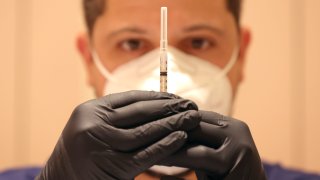
- Dr. Peter Marks, head of the FDA's vaccine division, said manufacturers should update their shots to target omicron BA.4 and BA.5 in addition to the original strain of the virus that first emerged in Wuhan, China.
- The FDA has asked the companies to start clinical trials on these newer subvariants, Marks said.
- The vaccine makers are having trouble keeping up with the rapid evolution of the virus.
- Pfizer and Moderna developed their omicron shots to target the original version of the variant, BA.1, which caused the massive wave of infection over the winter.
The Food and Drug Administration on Thursday said vaccine manufacturers should update their Covid-19 booster shots to target the most recent omicron subvariants that are gaining ground in the U.S.
Dr. Peter Marks, head of the FDA's vaccine division, said manufacturers should update their shots to target omicron BA.4 and BA.5 in addition to the original strain of the virus that first emerged in Wuhan, China.
The FDA wants to update the booster shots to provide longer lasting protection ahead of the fall, when public health experts expect another wave of infection as immunity from the vaccines wanes and people spend more time indoors — where Covid spreads more easily — in the colder weather.
Get top local stories in Connecticut delivered to you every morning. Sign up for NBC Connecticut's News Headlines newsletter.
The two-dose primary vaccination series won't immediately change, Marks said. In other words, people who are fully vaccinated will not be starting from scratch in the fall. They would simply receive an omicron shot to increase their protection against the virus. People who are not yet vaccinated would first get two doses of the original vaccine, and then likely a jab with the new version.
Marks said the FDA will review the new vaccines for safety, effectiveness and manufacturing quality to ensure they meet the highest standards before they are authorized for public use.
The FDA's panel of independent experts voted overwhelmingly on Tuesday to recommend a new formula after an all-day meeting in which they evaluated the pros and cons of updating the shots ahead of a fall booster campaign in the U.S.
Money Report
But the vaccine makers are having trouble keeping up with the rapid evolution of the virus. Pfizer and Moderna developed their shots to target the original version of the variant, BA.1, which caused the massive wave of infection over the winter that slammed hospitals with sick patients.
But BA.1 has been pushed out by new subvariants and is no longer circulating in the U.S. Omicron BA.4 and BA.5 now make up more than 50% of Covid infections in the U.S., according to the Centers for Disease Control and Prevention.
It's unclear how long it will take the vaccine makers to switch gears and develop shots that include BA.4 and BA.5. The FDA has asked the companies to start clinical trials on these newer subvariants, Marks said. The FDA panel of experts generally favored targeting BA.4 and BA.5 in an effort to keep up with the evolution of the virus.
Pfizer and Moderna presented clinical trial data on Tuesday demonstrating that their updated shots triggered a stronger immune response against omicron BA.1 than the original version of the vaccines that the FDA authorized for use in December 2020. The updated shots, based on BA.1, did not perform as well against BA.4 and BA.5 though the immune response was still robust, according to the data.
The studies were small with only a few hundred participants, and there's currently no data on how well the shots will perform in the real world. The immune response is generally viewed as a good indicator of how well the vaccines will protect against illness.
Some FDA panel members said more data is needed on the effectiveness of new shots before rolling them out. Other panel members said it's unclear what impact adding a new component to the vaccines might have on a form of heart inflammation called myocarditis. Pfizer's and Moderna's shots are associated with an elevated risk of myocarditis in adolescent boys after the second dose. However, Covid infection carries a higher risk of myocarditis than vaccination, according to the CDC.
The U.S. is short on both time and money to get new vaccines ready for the fall. The manufacturers only have three months to produce the shots, but even if they meet the timeline the U.S. might not have the funds to be able to purchase vaccines for everyone.
Congress has not passed funding for the U.S. to buy vaccines for the fall, and the Biden administration has warned it might only have enough money to purchase shots for people at high risk of illness, like the elderly. The White House has shifted $5 billion from other parts of the pandemic response to start negotiations with the vaccine makers.
All of the currently authorized Covid vaccines are based solely on the original version of the virus that emerged in China in 2019. The shots are no longer providing the same level of protection against infection and mild illness because the virus has heavily mutated. They are still generally good at preventing severe disease, though there's concern this protection will also wane as the virus continues to evolve.
The virus has a protein called a spike that it uses to invade human cells. The current shots use copies of the spike from the original version of the virus to trigger an immune response that protects against illness. The immune response sends antibodies that recognize the virus spike and block it from invading human cells.
However, the antibodies triggered by the original vaccines are having difficulty recognizing the highly mutated versions of the spike on the omicron subvariants. In other words, omicron is slipping through the defensive walls erected by the vaccines, causing infections and mild illness even in people who have kept up with their shots.






